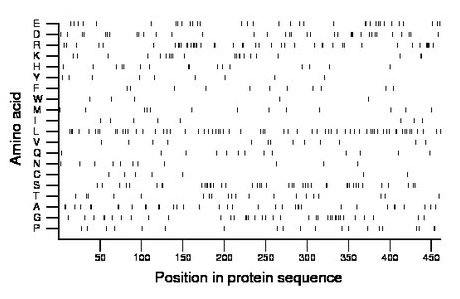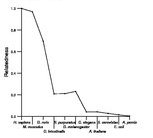
| Name: USH1G | Sequence: fasta or formatted (461aa) | NCBI GI: 34304383 | |
|
Description: Usher syndrome 1G protein
|
Referenced in: Ankyrin Family
| ||
|
Composition:

Amino acid Percentage Count Longest homopolymer A alanine 7.8 36 2 C cysteine 1.5 7 1 D aspartate 7.6 35 3 E glutamate 7.4 34 2 F phenylalanine 2.4 11 1 G glycine 8.0 37 2 H histidine 3.5 16 2 I isoleucine 1.7 8 1 K lysine 4.6 21 2 L leucine 14.1 65 2 M methionine 2.8 13 1 N asparagine 2.4 11 1 P proline 4.3 20 2 Q glutamine 2.8 13 1 R arginine 9.5 44 4 S serine 9.3 43 2 T threonine 4.3 20 1 V valine 2.8 13 1 W tryptophan 1.1 5 1 Y tyrosine 2.0 9 1 |
Comparative genomics:
Search single species RefSeq proteins at NCBI
Search summary 
Figure data | ||
Related human proteins:Protein Relative score Description Self-match 1.000 Usher syndrome 1G protein ANKS4B 0.343 harmonin-interacting ankyrin-repeat containing prot... ESPN 0.058 espin KIDINS220 0.055 kinase D-interacting substrate of 220 kDa ANKRD10 0.051 ankyrin repeat domain 10 ANKRD42 0.050 ankyrin repeat domain 42 ANKRD50 0.050 ankyrin repeat domain 50 ASB3 0.047 ankyrin repeat and SOCS box-containing protein 3 iso... ASB3 0.047 ankyrin repeat and SOCS box-containing protein 3 isof... EHMT2 0.047 euchromatic histone-lysine N-methyltransferase 2 is... EHMT2 0.047 euchromatic histone-lysine N-methyltransferase 2 is... ANKRD28 0.047 ankyrin repeat domain 28 ESPNL 0.047 espin-like ANK2 0.045 ankyrin 2 isoform 3 ANK2 0.045 ankyrin 2 isoform 2 ANK2 0.045 ankyrin 2 isoform 1 ANK3 0.045 ankyrin 3 isoform 1 RIPK4 0.045 ankyrin repeat domain 3 ANKRD17 0.045 ankyrin repeat domain protein 17 isoform a ANKRD17 0.045 ankyrin repeat domain protein 17 isoform b ANKRD44 0.044 ankyrin repeat domain 44 ANKRD54 0.044 ankyrin repeat domain 54 ANKRD52 0.044 ankyrin repeat domain 52 RFXANK 0.044 regulatory factor X-associated ankyrin-containing pro... TANC1 0.043 tetratricopeptide repeat, ankyrin repeat and coiled... TANC1 0.043 tetratricopeptide repeat, ankyrin repeat and coiled... TANC2 0.043 tetratricopeptide repeat, ankyrin repeat and coiled... CTTNBP2 0.043 cortactin binding protein 2 ANKK1 0.042 ankyrin repeat and kinase domain containing 1 ANKRA2 0.042 ankyrin repeat, family A (RFXANK-like), 2Human BLASTP results (used to prepare the table) | |||
Gene descriptions are from NCBI RefSeq. Search results were obtained with NCBI BLAST and RefSeq entries. When identical proteins are present, the self-match may not be listed first in BLASTP output. In such cases, the table above has been reordered to place it first.
See About the Figures for the scoring system used in the figure above right. The same scoring system was used in the table of BLASTP results.
Guide to the Human Genome
Copyright © 2010 by Stewart Scherer. All rights reserved.
